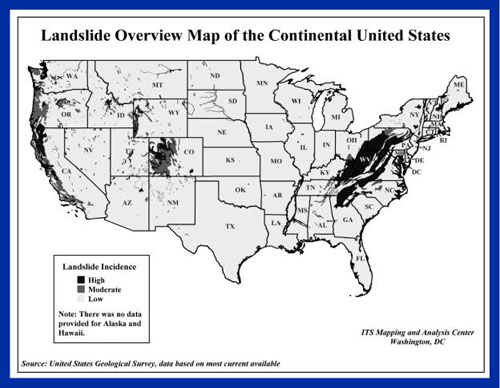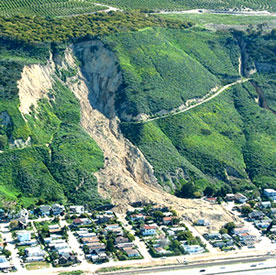
Landslides occur in all U.S. states and territories. In a landslide, masses of rock, earth, or debris move down a slope. Landslides may be small or large, slow or rapid. They are activated by storms, earthquakes, volcanic eruptions, fires, and human modification of land.
Debris and mud flows are rivers of rock, earth, and other debris saturated with water. They develop when water rapidly accumulates in the ground, during heavy rainfall or rapid snowmelt, changing the earth into a flowing river of mud or slurry. They flow can rapidly, striking with little or no warning at avalanche speeds. They also can travel several miles from their source, growing in size as they pick up trees, boulders, cars, and other materials.
Landslide problems can be caused by land mismanagement, particularly in mountain, canyon, and coastal regions. Land-use zoning, professional inspections, and proper design can minimize many landslide, mudflow, and debris flow problems.
Take Protective Measures
Before a Landslide or Debris Flow
The following are steps you can take to protect yourself from the effects of a landslide or debris flow:
- Do not build near steep slopes, close to mountain edges, near drainage ways, or natural erosion valleys.
- Get a ground assessment of your property.
- Consult an appropriate professional expert for advice on corrective measures.
- Minimize home hazards by having flexible pipe fittings installed to avoid gas or water leaks, as flexible fittings are more resistant to breakage (only the gas company or professionals should install gas fittings).
Recognize Landslide Warning Signs
- Changes occur in your landscape such as patterns of storm-water drainage on slopes (especially the places where runoff water converges) land movement, small slides, flows, or progressively leaning trees.
- Doors or windows stick or jam for the first time.
- New cracks appear in plaster, tile, brick, or foundations.
- Outside walls, walks, or stairs begin pulling away from the building.
- Slowly developing, widening cracks appear on the ground or on paved areas such as streets or driveways.
- Underground utility lines break.
- Bulging ground appears at the base of a slope.
- Water breaks through the ground surface in new locations.
- Fences, retaining walls, utility poles, or trees tilt or move.
- A faint rumbling sound that increases in volume is noticeable as the landslide nears.
- The ground slopes downward in one direction and may begin shifting in that direction under your feet.
- Unusual sounds, such as trees cracking or boulders knocking together, might indicate moving debris.
- Collapsed pavement, mud, fallen rocks, and other indications of possible debris flow can be seen when driving (embankments along roadsides are particularly susceptible to landslides).

During a Landslide or Debris Flow
The following are guidelines for what you should do if a landslide or debris flow occurs:
- Move away from the path of a landslide or debris flow as quickly as possible.
- Curl into a tight ball and protect your head if escape is not possible.
After a Landslide or Debris Flow
The following are guidelines for the period following a landslide:
- Stay away from the slide area. There may be danger of additional slides.
- Check for injured and trapped persons near the slide, without entering the direct slide area. Direct rescuers to their locations.
- Watch for associated dangers such as broken electrical, water, gas, and sewage lines and damaged roadways and railways.
- Replant damaged ground as soon as possible since erosion caused by loss of ground cover can lead to flash flooding and additional landslides in the near future.
- Seek advice from a geotechnical expert for evaluating landslide hazards or designing corrective techniques to reduce landslide risk.
 Print
Print Email
Email







